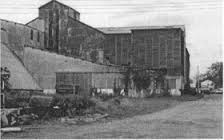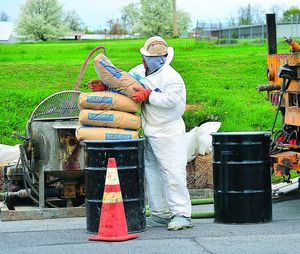 |
| Long Overdue |

The Information that I am posting is collected from Newspapers, EPA and etc. I am just placing it here for all to read and to express their opinions and feelings. I am not responsible if any documents have errors. My name is Margie Rogers Swope, I grew up on George Street in Hagerstown, Maryland. I now reside in Florida with my husband, Larry. Many of us grew up close to the Central Chemical Corp.
Central Chemical Corp.
| History of Central Chemical Corp. In important ways, the circumstances surrounding Thomas’s entry into the fertilizer business were not propitious. First, Thomas began business near the end of a half-century-long relocation of the fertilizer industry’s center. Though fertilizer use continued to increase in the Mid-Atlantic states and elsewhere during the period from 1870 to 1920, the manufacture of fertilizer began to shift to the Southern states in the late nineteenth century. By 1902, Charleston had replaced Baltimore as the fertilizer capital of the country. The Mid-Atlantic states’ share of total fertilizer use decreased from 34% in 1880 to 14% in 1920. By contrast, in 1920 the South-Atlantic states used about 50% of all fertilizers consumed in the U.S. Thus, Hagerstown could no longer enjoy proximity to the major centers of fertilizer-material production, and, while previously situated between the two highest-fertilizer-use regions of the country, it now found itself on the northern edge of a region that now dwarfed all others. Second, Thomas’s decision to continue in the practice (apparently favored by Hagerstown companies) of making fertilizer primarily from bone and organic materials came at the start of a rapid increase in the demand for mixed fertilizers, but also at the beginning of a precipitous decline in the use of bone and bone products as a source of phosphorous in fertilizers. With the growing use of potash and phosphate rock, consumption of mixed fertilizers grew from 46% of the total in 1880 to around 70% in 1920. During the period from 1890 to 1910, when Thomas was focusing on his presumably unmixed “dissolved bone” fertilizers, mixed fertilizers were capturing market share. Furthermore, the period from 1880 to 1920 is also characterized by the decreasing use of organic materials in general. Though organic materials provided about 91% of the total nitrogen in 1900, by 1917 the total nitrogen contribution from organics had dropped to 46.5%. With regard to phosphates, bone meal, dissolved bones and boneblack, and phosphoro-guano use peaked in 1890, but their use dropped to a negligible amount by 1910 as the use of superphosphates from phosphate rock increased dramatically.. Third, even as Thomas had begun his business trading fertilizer for livestock from relatively distant places, the fertilizer industry was increasingly turning to local distribution. Though mid-nineteenth-century fertilizer plants typically were situated in East Coast harbor cities, twentieth-century plants were dispersed to be closer to areas of consumption. Finally, even though the name “Thomas’ Dissolved Bone” suggests that Thomas produced his own superphosphates initially, the use of bone in the production of superphosphates was on its way out as described above. For all practical purposes, then, Thomas had set his business on the track of the second, smaller type of fertilizer company, which only mixed fertilizer and did not produce superphosphates. For the next 90 years, even when Central Chemical had affiliates across the nation, it would remain in this “smaller” category – relying on large suppliers for its materials. For reasons noted above, this was not a problem at the turn of the century vis-à-vis the larger companies. Starting in the 1890s, however, many agricultural societies began to advocate home mixing of fertilizer materials by farmers. Throughout the first half of the twentieth century, the fertilizer industry fought this effort successfully by insisting on the value of industrial mixing processes and the farmer’s comparative disadvantages in mixing. Though in its early years, Central Chemical advertised itself as “Exporters – Manufacturers – Importers,” by the 1970s it had become little more than a middle-man between larger suppliers and farmers. It did not import its own materials, but purchased granulated materials from suppliers. There is no evidence that Central Chemical was exporting products out of the country anymore. And its manufacturing capacity consisted of mixing pre-processed granulated materials in various proportions. At this point, its consulting capacity became equally important to its factory processes. Though Central Chemical and its subsidiaries were taking in a combined $25 million in sales by the late 1970s, an employee remembers that there was always a sense of trouble on the horizon. The vulnerability of a company that adds very little value to its product and relies entirely on contracts with larger suppliers requires no explanation. It appears that not long after Central Chemical became a bulk blender, its large suppliers began pushing their advantages. In the early 70s, Central Chemical’s supplier, Agrico Chemical Company, put pressure on Central Chemical to enter into a long-term contract. When Central Chemical refused, Agrico withheld di-ammonium phosphate and granular triple super phosphate at a time of national shortage in these materials. Central Chemical responded by filing an antitrust lawsuit against Agrico in federal court. For most of the next decade much of the time, resources, and energy of what was still a closely-held corporation would be consumed in this litigation. Ultimately the lawsuit proved unsuccessful. All of this came at the same time that local, state, federal regulators were investigating the Hagerstown plant for its pesticide-disposal practices. In the 1970s the State of Maryland ordered two separate cleanups of the site; the EPA was just getting started. Ultimately the push to eliminate the middle man that drove the switch to bulk blending began to turn on the blenders themselves. The larger companies and farmers wised up, and realized that they could both save money by dealing directly with each other. Farmers began buying direct-application materials from the same suppliers used by Central Chemical. By the early 1980s, Central Chemical’s network of fertilizer blenders had contracted substantially. Blending operations like those of the Hagerstown plant could no longer make the case for themselves. Crushed under the weight of increasingly serious environmental liability for its mid-century disposal practices, the Central Chemical Corporation contracted its operations substantially. The Hagerstown plant ceased operations in 1984 and the office headquarters moved from the old Thomas building to an office outside Hagerstown. |
Translate
Sunday, August 30, 2015
Superfund Site Cleanup LONG OVERDUE
Thursday, August 27, 2015
EPA website regarding ground water & Lindane By Tim Jordan
Site status: Sept. 2009
Lindane
Human Health Harms
- Neurological Effects: Humans exposed accidentally to high levels of lindane have experienced seizures, convulsions, vertigo, and abnormal EEG patterns (ATSDR).
- Cancer: Lindane is associated with elevated risks of non Hodgkin's lymphoma, liver, and breast cancer (ATSDR). California's Proposition 65 lists lindane as a chemical known to cause cancer.
- Endocrine Disruption: Lindane has been reported to interfere the hormone levels of human males exposed to the insecticide (ATSDR). In labratory studies, lindane mimicks estrogen in female rats and mice (Beyond Pesticides Factsheet).
- Reproductive Effects: Pregnant women who miscarried or had pre-term babies had higher levels of lindane as well as other organochlorine pesticides in their blood. Lindane is also linked to reduced sperm counts, and decreased ovulation in animal studies (ATSDR).
- Immunological Effects: Lindane is thought to impact the human immune system. Workers exposed to lindane experienced increased levels of antibodies in their blood (ATSDR).
- Liver Toxicity: Exposure to lindane is linked to increased levels of liver enzymes, increased liver weight and liver toxicity (ATSDR).
Environmental Contamination
Lindane Alternatives
- NPA's Ten Tips for Head Lice and Nit Removal
- NPA's Ten Tips for Head Lice Prevention
- Beyond Pesticides Fact Sheet - Least Toxic Head Lice & Scabies Control
- Sierra Club Canada Fact Sheet - PDF file
Resources
Research & Chemical Factsheets
- ASTDR Toxicological Factsheet and Toxicological Profile for Lindane
- EXTOXNET Lindane Pesticide Information Profile.
- PAN Pesticide Database
- Beyond Pesticides Lindane Fact Sheet
- Lindane: Answers to Common Questions
- Lindane Risk Assessment Factsheet. U.S. EPA
- Lindane Reregistration Eligibility Decision Addendum. U.S. EPA
- Revised Assessment of Risk from Use of Lindane for Treatment of Lice and Scabies. U.S. EPA.
- Canadian Arctic Contaminants Assessment Report II: Sources, Occurence, Trends, & Pathways in the Physical Enviornment.
- CDC Fourth National Report on Human Exposure to Environmental Chemicals.
- Report - Chemical Trespass: Pesticides in our Bodies and Corporate Accountability
- Report - Lindane's Dirty Secret: Indian Facilities Dump Toxic Waste
- Girl Dies After Eating Small Amount of Lindane Ant Powder, April 2002
- Lindane and Chocolate, August 2001
- Of Lice and Libel , Detroit Metro Times. August 23, 2006.
- Fatality After a Single Dermal Application of Lindane Lotion, Environmental & Occupational Health. 2007.
Tuesday, August 25, 2015
Central Chemical 1924
The plant is a modernly constructed fertilizer plant, equipped with two mixing machines, having
a combined manufacturing and shipping capacity of 300 Tons per day.
http://newspaperarchive.com/profile/tim-jordan/clipnumber/17477/
Plaintiffs seek $750 million in Fort Detrick pollution suit
Sunday, August 23, 2015
This is just pathetic... By Erin Brockovich
Tuesday, August 18, 2015
History of the Central Chemical Corp. site cleanup
Herald Mail
History of the Central Chemical Corp. Site Cleanup
EPA: Firms to pay $14.3M to clean up Central Chemical site in Hagerstown Central Chemical superfund site
Aerial Map of Central Chemical 1931
 |
| This photo is from http://digital.hagley.org/ If anyone wants to reproduce this, you'll need to contact the email listed. I'm considering the image here "fair use" since it's not for profit and factual in nature. |
Dumped into the Central Chemical Quarry- Results by Ken Buckler
Thursday, August 13, 2015
Testing continues at Hagerstown pesticide cleanup site
 |
Superfund site
A workman loads concrete mix Thursday at a well site at Langdon Street and Linganore Avenue near the former Central Chemical plant Superfund site.
|

- Posted on Apr 30, 2015by CJ Lovelace





